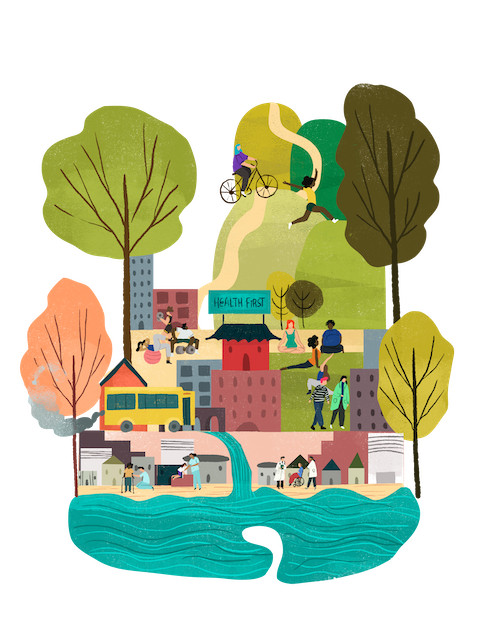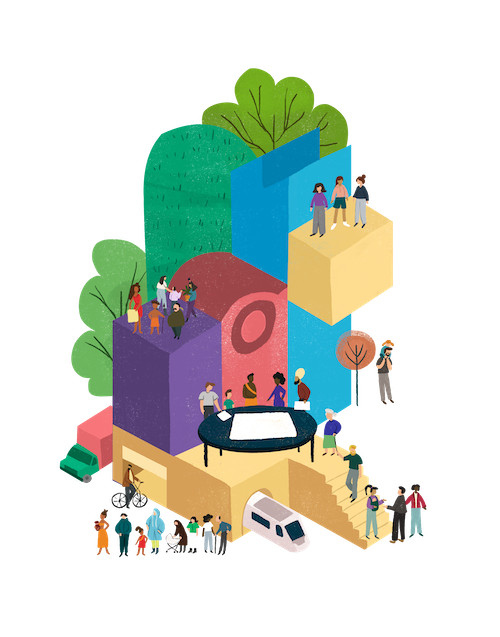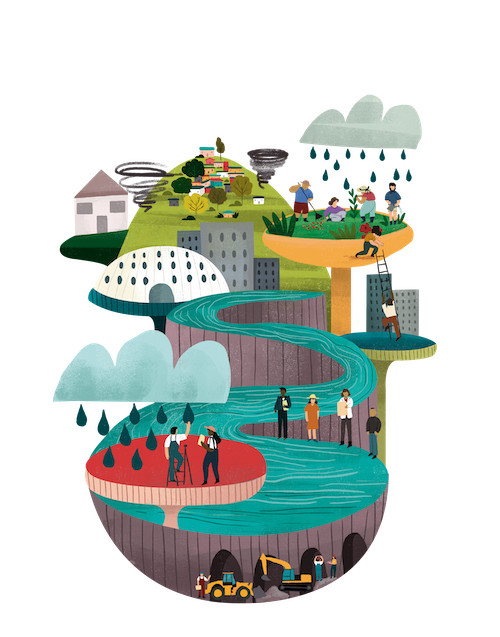
UN-Habitat has just released its annual World Cities Report during the eleventh session of the World Urban Forum, which took place in Katowice, Poland from June 27 until June 30, 2022. Titled “Envisaging the Future of Cities”, the 2022 release highlights insights on the future of the urban realm, based on “existing trends, challenges, and opportunities, as well as disruptive conditions, including the valuable lessons from the COVID-19 pandemic”. In fact, it seeks to present cities with ways to be prepared for future challenges and address current issues.
As the global population living in urban areas is set to rise from 56 percent in 2021 to 68 percent in 2050, mainly in Africa and the Middle East, transforming our cities in order to achieve a better future should be a global interest. Urgently needing “innovative solutions for urban areas to respond to this triple C crisis of COVID, climate and conflict” as stated by UN Under-Secretary-General and Executive Director of UN-Habitat Maimunah Mohd Sharif, the 2022 World Cities Report calls for greater commitment by national, regional and local governments, and encourages the further adoption of innovative technologies and urban living concepts.
Read on to discover excerpts from the chapters with key findings of this report, find more info on UN-Habitat's official website, and download the World Cities Report 2022.
1-The Diversity and Vision for the Future of Cities

"While the COVID-19 pandemic dominated the two years between editions of the World Cities Report and upended many aspects of urban life, this Report comes at a time when world events create ever more dynamic environments for urban actors. Although of the world has lifted the public health restrictions and border closures that made COVID-19 such a dominant aspect of urban life, the virus continues to flare up periodically and some countries still have strict measures in place. Recently, the world has witnessed a sudden global spike in inflation and cost of living, alongside supply chain disruptions, which is severely affecting the recovery of urban economies. New and persistent armed conflicts have altered the geopolitical order and contributed to global economic uncertainty."
Key Messages
- The emergence of urbanization as a global mega-trend is intertwined with the existential challenges that the world has faced in the last 50 years.
- Building economic, social, and environmental resilience, including appropriate governance and institutional structures, must be at the heart of the future of cities.
- The disruptive nature of COVID-19 and the emerging global uncertainties are all stark reminders that urban areas need to be prepared for an ever-changing and unpredictable future.
- Any vision for an optimistic future of cities must embody a new social contract with universal basic income, health coverage and housing.
- Localizing the New Urban Agenda and SDG 11 is the most promising pathway to the optimistic scenario of urban futures.
2-Scenarios of Urban Futures: Degree of Urbanization

"A new harmonized definition, called the Degree of Urbanization, facilitates international comparisons of urbanization. By defining three main classes of human settlements (cities, towns and semi-dense areas, and rural areas), the Degree of Urbanization captures the urban-rural continuum as recommended by research. It provides a pathway to overcoming the fundamental challenge linked to monitoring urban trends and the development agendas that has lingered over the years: the lack of a unified definition of what constitutes “urban” and its precise measurement. This chapter provides a unique perspective on future trends using Degree of Urbanization and data emanating from this new harmonized approach. Specifically, it provides scenarios that allow us to understand the anticipated demographic and spatial changes across the urban-rural continuum in various regions as well as their drivers."
Key Messages
- City densities in low-income countries need to be planned for and managed in ways that future growth does not exert pressure on existing open land, infrastructure and services, and result in crowding on the one hand or lead to unsustainable sprawl on the other.
- Enhanced planning capacities for small cities and emerging newer cities will strengthen the important role they play across the urban-rural continuum in achieving sustainable futures.
- Planning for age-friendly cities and towns that afford good quality of life for all inhabitants across all generations is critical for sustainable futures.
- Effective urban and territorial planning is critical to mitigate the negative social, economic and environmental associated with future urban growth.
- Effective urban and territorial planning is critical to mitigate the negative social, economic and environmental associated with future urban growth.
3-Poverty and Inequality: Enduring Features of an Urban Future?

"Cities generate wealth but also concentrate poverty and inequality. From the overcrowded slums in the developing world to homelessness and pockets of destitution in the developed world, urban poverty and inequality take many forms. We cannot envision a bright future for cities when inequality appears to be on the rise globally and poverty in certain regions. How to tackle poverty and inequality are among the most pressing challenges facing urban areas; and improving income and a wide range of opportunities for all is essential to achieving an optimistic urban future. The global development agenda gives prime of place to the issue, with SDG 1, which calls for a world in which we “end poverty in all its forms everywhere.” If urban poverty is not addressed, then this goal will remain elusive."
Key Messages
- The vision of equitable urban futures will not be achieved unless cities and subnational governments take bold actions to address the pervasive presence of urban poverty and inequality.
- Within the Decade of Action window (2020–2030), cities and subnational governments should adopt a multidimensional approach to addressing poverty and inequality.
- Investing in and extending infrastructure and services to deprived neighborhoods is a critical policy lever to address poverty and inequality.
- Supporting informal employment is critical for building inclusive urban futures.
- Gender transformative approaches are crucial for building inclusive urban futures.
4-Resilient Urban Economies: A Catalyst for Productive Futures

"The urban economy is integral to the future of cities. Given the size of the contribution of cities to the national economy, the future of many countries will be determined by the productivity of its urban areas. People first gathered in denser human settlements for the purpose of trading at markets, and this fundamental aspect of urban life has evolved over time. Today’s urban economies are complex systems tied to global trade and capital flows, in which foreign entities can own the property next door and distant events can affect the prices for local goods. Cities must be smarter than ever about how they position their economies for the maximum benefit of all residents while also safeguarding the environment and improving their city’s quality of life."
Key Messages
- Cities should prioritize economic diversification as a critical pillar for building resilient urban economies and productive urban futures in line with the New Urban Agenda.
- Sustainable urban and territorial planning supported with effective governance structures is critical for building resilient urban economies and productive urban futures.
- Urban economies are more productive in peaceful and stable societies.
- Governments should implement targeted interventions such as tailored social safety nets to strengthen the capabilities of marginalized groups.
- Sustainable and innovative municipal finance are fundamental for optimistic urban futures.
5-Securing a Greener Urban Future

"Climate change and environmental concerns increasingly dominate future scenarios. The increase in extreme weather events and natural disasters like flooding, heatwaves and landslides will impact urban areas the hardest, which makes climate change adaptation a paramount concern. Meanwhile, urban areas are responsible for a majority of the world’s carbon emissions. As such, the transition to net zero greenhouse gas emissions must occur as soon as feasibly possible. Cities can do their part by embracing a wide range of options."
Key Messages
- Achieving net zero is also dependent on subnational and city-level action. Policymakers at all levels must therefore recognize and support the role of urban areas in the net zero transition.
- Nature-based solutions must be part of inclusive planning processes for sustainable urban futures—local action to secure greener futures cannot overlook their vital role.
- In environmental decision-making, diverse voices and perspectives must be heard to minimize uncertainties in the pathways to securing greener urban futures.
- Various levels of government and institutions should harness the potential of international partnerships such as transnational networks and social movements in delivering greener urban futures.
6-Urban Planning for the Future of Cities

"Cities are complex systems that grow, develop and even shrink based on a variety of forces. Planning is an essential tool for shaping the future of cities, as unplanned human settlements are prone to sprawl, inefficient land use, poor connectivity and a lack of adequate municipal services. Good urban planning is one of the three pillars of sustainable cities, without which cities are unlikely to achieve the optimistic scenario of urban futures."
Key Messages
- Post-COVID recovery programs should not only focus on economic recovery but also on social inclusion and climate action.
- The importance of compact development, managed density and prevention of overcrowding in city resilience should be re-emphasized in view of rising concerns over overcrowding in cities during pandemics.
- Cities should implement best practices and policy tools such as sustainable neighborhood planning, the 15-minute city concept and sustainable urban mobility plans (SUMPs) that have been effective in making cities more resilient.
- Safe, affordable, and reliable public transport systems are sustainable and should be integrated with active mobility.
- There is an urgent need to focus on strengthening integrated urban and territorial planning approaches that consider interactions between urban, peri-urban and rural areas.
7-Public Health and Sustainable Urban Futures

"As history attests, the resilience and scalability of cities is undergirded by effective public health. Beyond hospitals, medicines and vaccines, equitable provision of health-promoting infrastructure such as green spaces, improved housing, clean and safe drinking water, and extensive sewer systems to safely dispose of human waste are necessary minimum components for securing public health in urban areas. While COVID-19 led to the first major global pandemic in a century, the future portends more epidemics and pandemics. Public health is now once again at the forefront in envisioning the future of cities."
Key Messages
- When health is recognized and acted upon as a priority across all urban interventions, there are vital possibilities to achieve multiple benefits for well-being and foster inclusive, resilient, and sustainable urban futures.
- Ongoing disaggregated data collection is essential to reveal the true picture of multi-layered rapidly changing urban health risks for effective policy formulation and action to ensure policymakers "leave no one behind."
- Challenges of health inequity—often rooted in geographic, political, and socioeconomic exclusion—can be tackled via place-based initiatives co-developed with residents to promote health in marginalized neighborhoods and support more equitable urban futures.
- Expanding Universal Health Care is a key priority in advancing health for inclusive, resilient, and sustainable urban futures as well as strengthening health system preparedness for a future of epidemics and pandemics.
- Responsive, accountable local governments play a pivotal role in developing effective holistic place-based interventions that can generate multiple co-benefits for health, inclusion and climate change mitigation.
8-Rethinking Urban Governance for the Future of Cities

"Whichever future urban challenge cities face, whether it is poverty, health, housing or the environment, urban governance always has a critical enabling role to ensure that the capacities and resources of institutions and people match their responsibilities and desires. Sustainable urban development is not possible without effective multilevel urban governance – including local governments, civil society and national governments. Governments have been severely tested since 2020, which means now is the time to rethink urban governance and put cities on the path to an optimistic future scenario."
Key Messages
- In an age of global threats and disruptions, such as pandemics, natural disasters and armed conflicts, urban governance needs to be flexible and adaptable.
- With cities being more culturally mixed, and with bigger distance between citizens and government, building trust and legitimacy are essential, including protecting data privacy.
- Governments need to have adequate political and institutional legitimacy, clearly defined roles and need capacity and resources that meet their responsibilities.
- There is a need for clearer and more decentralized regulatory frameworks to enable more own-source revenue, municipal borrowing and bond issuance and more regular government transfers.
- Government must revise their relationship between the private sector and civil society, with special attention to underrepresented groups to co-create strategies such as re-municipalization, community-led finance and forms of co-production of urban services.
9-Innovation and Technology: Towards Knowledge-Based Urban Futures

"Advances in technology and urban futures are inextricably linked. The future of cities will be knowledge-based, driven largely by innovation and the widespread use of new technologies and digitization of virtually all facets of urban life. Technological innovations define the twenty-first century. Cities are going through a wave of digitalization that is reshaping how urban dwellers live, work, learn and play. Technology holds great promise for improving urban livelihoods, but there are also risks that smart city technology will invade privacy. Cities, meanwhile, are competing for innovation-based businesses in a race that will create both winners and losers in urban futures."
Key Messages
- The deployment of innovation and technology should be tailored to suit the diversity of the urban context.
- Cities need to consider the negative environmental externalities when investing in low-carbon, digital and connected technologies.
- Urban economies need to be adequately prepared for the effects of advancing automation and digitalization.
- To avoid top-down, one-way communication, the deployment of digital tools to address urban challenges needs to be inclusive, collaborative and empowering.
10-Building Resilience for Sustainable Urban Futures

"Any scenario of urban futures outlined in this Report will face unexpected shocks and stresses. Will a given city collapse like a house of cards or withstand whatever unpredictable future comes their way? The answer to that question lies in a city's resilience, a capacity that bookends all of the discussion up to this point. A key message running through this Report is that building economic, social and environmental resilience, including appropriate governance and institutional structures must be at the heart of the future of cities. Cities that are well-planned, managed and financed have a strong foundation to prepare for such unknown future threats. Moreover, cities that are socially inclusive and work for all their residents are also better positioned to face environmental, public health, economic, social and any other variety of shock or stress, as cities are only as strong as their weakest link."
Key Messages
- Building resilience for sustainable urban futures requires an integrated linkage of the various pillars of the global sustainable development agenda.
- Building urban resilience is a multisectoral, multidimensional, multi-stakeholder process that requires a clear change of trajectory from previous paths.
- Effective urban resilience capacity building requires mainstreaming across local governments.
- Governments have a roadmap to urban resilience in the global sustainable development agenda.
- Cities, subnational governments and other urban actors should urgently prioritize bottom-up approaches when designing urban resilience interventions.
- Building resilience requires innovative, and sustainable financing instruments beyond the traditional fiscal tools at the disposal of cities and national governments.
- Integrated urban planning is an essential component and prerequisite for resilient urban futures.
- Extending social protection to informal sector workers is critical for inclusive development and resilient urban futures.
- Investing in key urban infrastructure must be a prerequisite for building sustainable and resilient urban futures.
- Policymakers must match urban risk assessments with appropriate solutions.
- Visioning and implementation of urban resilience plans must prioritize the poorest and most vulnerable communities.
- Building urban resilience will not succeed without public participation.
This article is part of the ArchDaily Topics: Cities and Living Trends. Every month we explore a topic in-depth through articles, interviews, news, and projects. Learn more about our ArchDaily topics. As always, at ArchDaily we welcome the contributions of our readers; if you want to submit an article or project, contact us.







